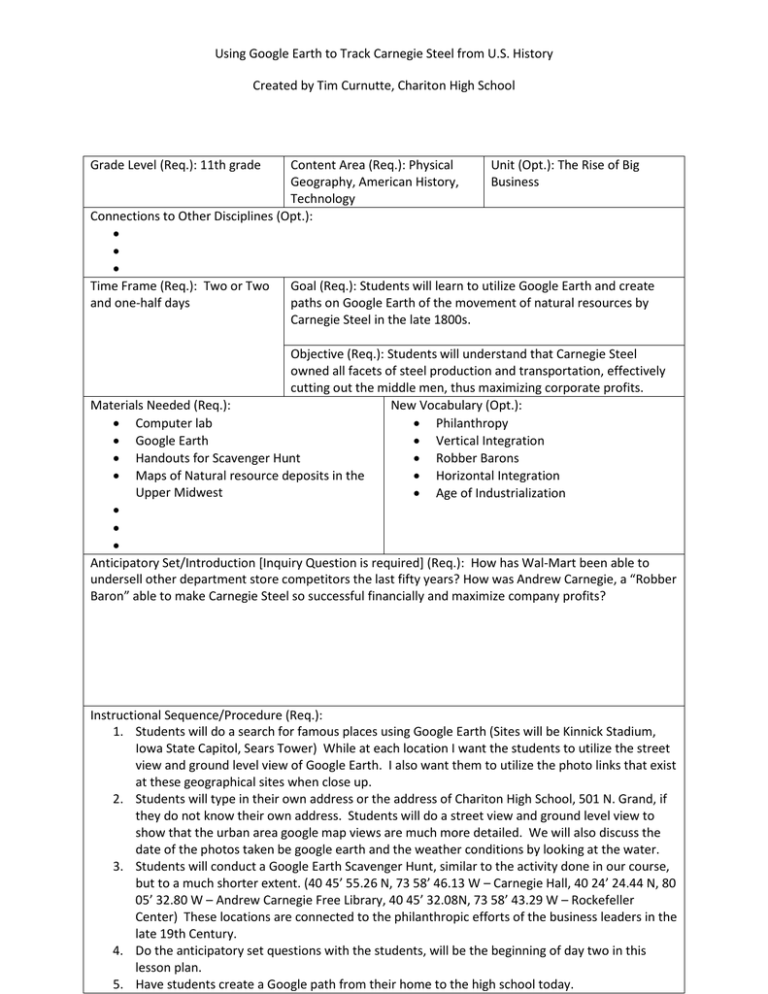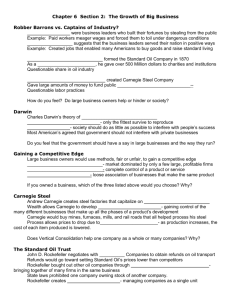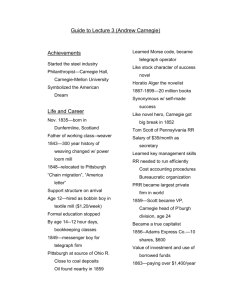Using Google Earth to Track Carnegie Steel from U.S. History
advertisement

Using Google Earth to Track Carnegie Steel from U.S. History Created by Tim Curnutte, Chariton High School Grade Level (Req.): 11th grade Content Area (Req.): Physical Unit (Opt.): The Rise of Big Geography, American History, Business Technology Connections to Other Disciplines (Opt.): • • • Time Frame (Req.): Two or Two Goal (Req.): Students will learn to utilize Google Earth and create and one-half days paths on Google Earth of the movement of natural resources by Carnegie Steel in the late 1800s. Objective (Req.): Students will understand that Carnegie Steel owned all facets of steel production and transportation, effectively cutting out the middle men, thus maximizing corporate profits. Materials Needed (Req.): New Vocabulary (Opt.): • Computer lab • Philanthropy • Google Earth • Vertical Integration • Handouts for Scavenger Hunt • Robber Barons • Maps of Natural resource deposits in the • Horizontal Integration Upper Midwest • Age of Industrialization • • • Anticipatory Set/Introduction [Inquiry Question is required] (Req.): How has Wal-Mart been able to undersell other department store competitors the last fifty years? How was Andrew Carnegie, a “Robber Baron” able to make Carnegie Steel so successful financially and maximize company profits? Instructional Sequence/Procedure (Req.): 1. Students will do a search for famous places using Google Earth (Sites will be Kinnick Stadium, Iowa State Capitol, Sears Tower) While at each location I want the students to utilize the street view and ground level view of Google Earth. I also want them to utilize the photo links that exist at these geographical sites when close up. 2. Students will type in their own address or the address of Chariton High School, 501 N. Grand, if they do not know their own address. Students will do a street view and ground level view to show that the urban area google map views are much more detailed. We will also discuss the date of the photos taken be google earth and the weather conditions by looking at the water. 3. Students will conduct a Google Earth Scavenger Hunt, similar to the activity done in our course, but to a much shorter extent. (40 45’ 55.26 N, 73 58’ 46.13 W – Carnegie Hall, 40 24’ 24.44 N, 80 05’ 32.80 W – Andrew Carnegie Free Library, 40 45’ 32.08N, 73 58’ 43.29 W – Rockefeller Center) These locations are connected to the philanthropic efforts of the business leaders in the late 19th Century. 4. Do the anticipatory set questions with the students, will be the beginning of day two in this lesson plan. 5. Have students create a Google path from their home to the high school today. 6. Give students information about the Carnegie Steel Company and discuss it a little. 7. Students will then look at the map on page 231 of our textbook, “The Americans,” and discuss the natural resource deposits used by Carnegie Steel and other industrial companies. 8. Provide students with this information, “In the 1890s Carnegie pushed for greater and greater vertical integration, as a way to cut costs and increase profits. He had previously acquired a dominant stake in Frick’s coke business and now leased recently-discovered ore deposits in Minnesota’s Messabi Range, purchased lake steamers to handle his ore traffic and bought and extended a railroad to link his steel works to Lake Erie – thereby guaranteeing an uninterrupted flow of raw materials to his manufactureing plants. (Source – Economic History.Net Encyclopedia article on Carnegie, Andrew.) 9. Students then create a google map of the transportation of iron ore deposits taken from the Messabi Range in Minnesota to Lake Superior through the Great Lakes to United States Steel Plant in Buffalo New York. Then after the steel is produced it was sent by railroad to Baltimore, Maryland. Use the map on page 239 of textbook, “The Americans,” to show the different railroads used to complete this journey. 10. Students will then save this path so that the instructor can check the path’s accuracy. 11. Ask students these questions, “Which form of transportation did Carnegie Steel utilize the most in the transportation of resources and the produced steel?” “Why did Carnegie’s company choose this form of transportation?” Who owned the lake steam ships? Who owned the railroad tracks and railroad engines? What do we call this total control of resources and transportation?” 12. 13. 14. 15. 16. 17. 18. 19. 20. Formative Evaluation (Req.): Students will create a Assessment (Req.): Given a list of ten specific Google path of iron ore deposits from the Messabi locations the students will write down the latitude Range to United States Steel Plant in Buffalo, New and longitude locations for two of those ten York. Then the steel was produced and shipped locations. via railroad to Baltimore, Maryland. This will also be put on a Google path to show the movement of resources and Carnegie’s control of all facets of steel production. Iowa Core Curriculum Standards Used (Req.): • Geography, grade 9-12: Understand the use of geographic tools to locate and analyze information about people, places, and environments. • Geography, grade 9-12: Understand how human factors and distribution of resources affect the development (of) society and the movement of populations. • History, grade 9-12: Understand the role of individuals and groups within a society as promoters of change or the status quo. • History, grade 9-12: Understand the effect of economic needs and wants on individual and group decisions. • • • • • • Common Core Curriculum Standards Used (Opt.): • • • • • NGS Standards Used (Req.): • The Changes That Occur in the Meaning, Use, Distribution, and Importance of Resources • How to Apply Geography to Interpret the Past • How to Use Maps and Other Geographic Representations, Tools, and Technologies to Acquire, Process, and Report Information From a Spatial Perspective • • • • • • • Five Themes of Geography Used (Req.): • Location • Place • Human-Environmental Interaction • Movement • 21st Century Universal Constructs (Opt.): School District Standards and Benchmarks (Opt.): • • • Other Disciplinary Standards (Opt.): • • • • • Other Essential Information (Opt.): Other Resources (Opt.): • Textbook maps of the Natural Resource deposits used by the Industrial Companies • • •





